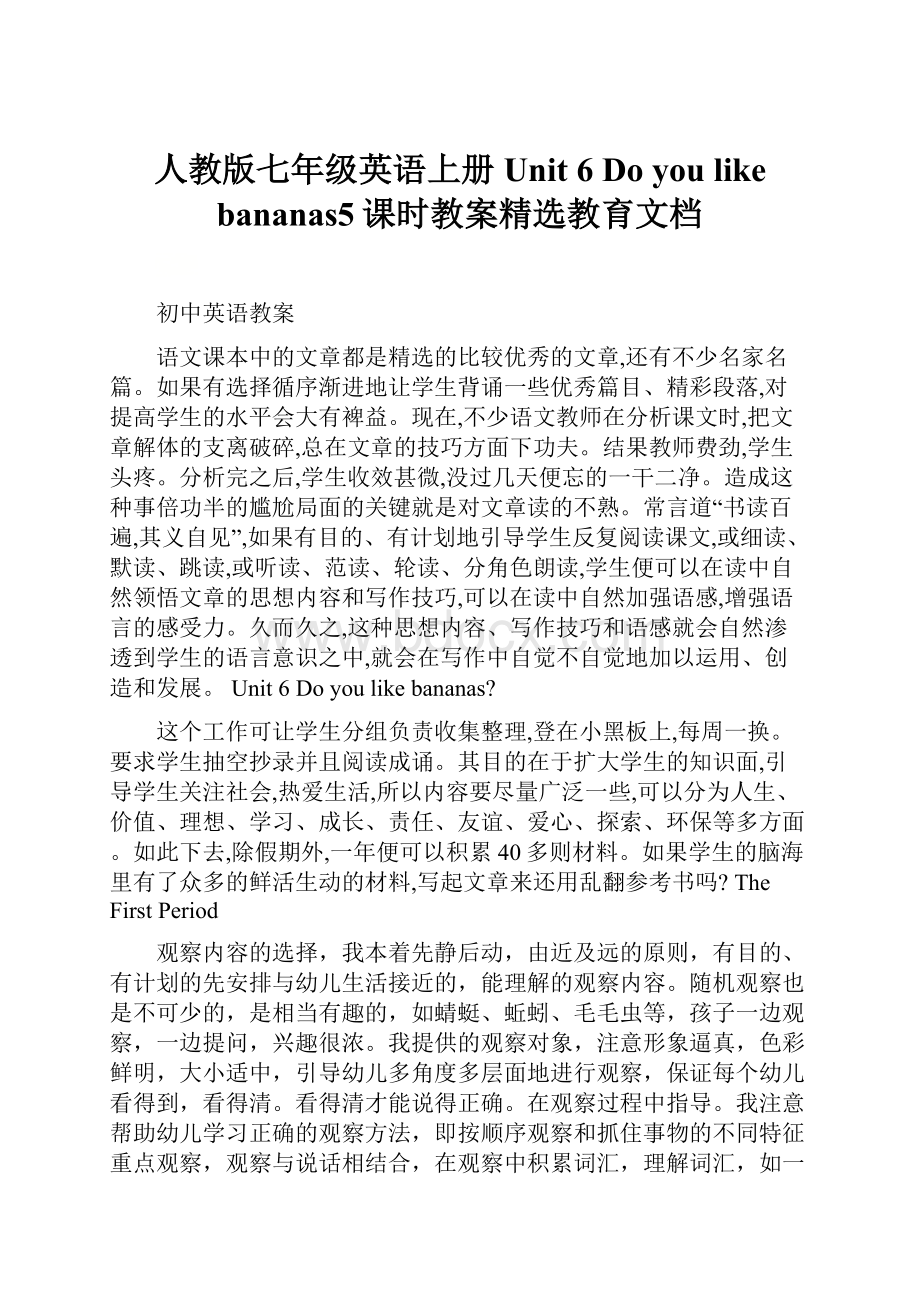人教版七年级英语上册Unit 6 Do you like bananas5课时教案精选教育文档.docx
《人教版七年级英语上册Unit 6 Do you like bananas5课时教案精选教育文档.docx》由会员分享,可在线阅读,更多相关《人教版七年级英语上册Unit 6 Do you like bananas5课时教案精选教育文档.docx(23页珍藏版)》请在冰豆网上搜索。

人教版七年级英语上册Unit6Doyoulikebananas5课时教案精选教育文档
初中英语教案
语文课本中的文章都是精选的比较优秀的文章,还有不少名家名篇。
如果有选择循序渐进地让学生背诵一些优秀篇目、精彩段落,对提高学生的水平会大有裨益。
现在,不少语文教师在分析课文时,把文章解体的支离破碎,总在文章的技巧方面下功夫。
结果教师费劲,学生头疼。
分析完之后,学生收效甚微,没过几天便忘的一干二净。
造成这种事倍功半的尴尬局面的关键就是对文章读的不熟。
常言道“书读百遍,其义自见”,如果有目的、有计划地引导学生反复阅读课文,或细读、默读、跳读,或听读、范读、轮读、分角色朗读,学生便可以在读中自然领悟文章的思想内容和写作技巧,可以在读中自然加强语感,增强语言的感受力。
久而久之,这种思想内容、写作技巧和语感就会自然渗透到学生的语言意识之中,就会在写作中自觉不自觉地加以运用、创造和发展。
Unit6Doyoulikebananas?
这个工作可让学生分组负责收集整理,登在小黑板上,每周一换。
要求学生抽空抄录并且阅读成诵。
其目的在于扩大学生的知识面,引导学生关注社会,热爱生活,所以内容要尽量广泛一些,可以分为人生、价值、理想、学习、成长、责任、友谊、爱心、探索、环保等多方面。
如此下去,除假期外,一年便可以积累40多则材料。
如果学生的脑海里有了众多的鲜活生动的材料,写起文章来还用乱翻参考书吗?
TheFirstPeriod
观察内容的选择,我本着先静后动,由近及远的原则,有目的、有计划的先安排与幼儿生活接近的,能理解的观察内容。
随机观察也是不可少的,是相当有趣的,如蜻蜓、蚯蚓、毛毛虫等,孩子一边观察,一边提问,兴趣很浓。
我提供的观察对象,注意形象逼真,色彩鲜明,大小适中,引导幼儿多角度多层面地进行观察,保证每个幼儿看得到,看得清。
看得清才能说得正确。
在观察过程中指导。
我注意帮助幼儿学习正确的观察方法,即按顺序观察和抓住事物的不同特征重点观察,观察与说话相结合,在观察中积累词汇,理解词汇,如一次我抓住时机,引导幼儿观察雷雨,雷雨前天空急剧变化,乌云密布,我问幼儿乌云是什么样子的,有的孩子说:
乌云像大海的波浪。
有的孩子说“乌云跑得飞快。
”我加以肯定说“这是乌云滚滚。
”当幼儿看到闪电时,我告诉他“这叫电光闪闪。
”接着幼儿听到雷声惊叫起来,我抓住时机说:
“这就是雷声隆隆。
”一会儿下起了大雨,我问:
“雨下得怎样?
”幼儿说大极了,我就舀一盆水往下一倒,作比较观察,让幼儿掌握“倾盆大雨”这个词。
雨后,我又带幼儿观察晴朗的天空,朗诵自编的一首儿歌:
“蓝天高,白云飘,鸟儿飞,树儿摇,太阳公公咪咪笑。
”这样抓住特征见景生情,幼儿不仅印象深刻,对雷雨前后气象变化的词语学得快,记得牢,而且会应用。
我还在观察的基础上,引导幼儿联想,让他们与以往学的词语、生活经验联系起来,在发展想象力中发展语言。
如啄木鸟的嘴是长长的,尖尖的,硬硬的,像医生用的手术刀―样,给大树开刀治病。
通过联想,幼儿能够生动形象地描述观察对象。
SectionA(1a-2d)
要练说,得练看。
看与说是统一的,看不准就难以说得好。
练看,就是训练幼儿的观察能力,扩大幼儿的认知范围,让幼儿在观察事物、观察生活、观察自然的活动中,积累词汇、理解词义、发展语言。
在运用观察法组织活动时,我着眼观察于观察对象的选择,着力于观察过程的指导,着重于幼儿观察能力和语言表达能力的提高。
Ⅰ.Teachingaims:
1.与当今“教师”一称最接近的“老师”概念,最早也要追溯至宋元时期。
金代元好问《示侄孙伯安》诗云:
“伯安入小学,颖悟非凡貌,属句有夙性,说字惊老师。
”于是看,宋元时期小学教师被称为“老师”有案可稽。
清代称主考官也为“老师”,而一般学堂里的先生则称为“教师”或“教习”。
可见,“教师”一说是比较晚的事了。
如今体会,“教师”的含义比之“老师”一说,具有资历和学识程度上较低一些的差别。
辛亥革命后,教师与其他官员一样依法令任命,故又称“教师”为“教员”。
Knowledgeaims:
(1)Keywords:
banana,hamburger,tomato,ice-cream,salad,strawberry,pear,milk,bread,birthday,
dinner,week,food,sure,vegetable,fruit,right,apple,then
(2)Keyphrases:
birthdaydinner,nextweek,thinkabout,howabout,whatabout
(3)Importantsentences:
—Doyoulikesalad?
—No,Idon’t.
—Doyoulikebananas?
—Yes,Ido.
Let’sthinkaboutthefood.
Howaboutburgers,vegetablesalad,andsomefruit?
Whataboutthefruit?
2.Abilityaims:
Talkaboutlikesanddislikes.
3.Emotionaims:
Makestudentsinterestedinallkindsofdeliciousfood.
.Importantpoints:
Learnaboutdifferentfoodsandspellthem.
.Difficultpoints:
Remembersomeimportantsentencessuchas“Howabout...?
”.
IV.Teachingprocess
Step1Warmingup
1.Showstudentsapictureofdifferentkindsoffood.First,letstudentssaysomewordsthatthey
knewbefore.Second,teachthemsomenewwords.
2.Teacherasksonestudent:
—Doyoulike...?
—Yes,Ido./No,Idon’t.
3.Letstudentspracticethisdialogueinpairs.
Step2Workon1a
1.Matchthewordswiththethingsinthepicture.
2.Checktheanswers.
3.Gametime!
(教师用PPT将实物逐个展示出来,同学们快速说出它是什么,第一个说出来的同学得一分)
Step3Listening
Workon1b.
1.Playtherecordingforstudentsandletthemnumberthepictures.
2.Checktheanswers.
Workon2a,2b.
1.Readthewordsthreetimesbythemselves.
2.Listenandcirclethefoodtheyhear.Checktheanswers.
3.Listenagainandtrytofillintheblanksin2b.
4.Practicethedialoguesinpairs.
Step4Pairwork
Workon1c.
Practicetheconversationswithyourpartner.
Choosesomepairstoactthemout.
Workon2c.
Step5Role-playtheconversation
Workon2d.
1.Letstudentsreadtheconversationforthefirsttime.Underlinesomekeyphrases.
2.Talkaboutthelanguagepoints.
3.Readtheconversationagainandanswerthefollowingquestions:
(1)WhatdoesJohnlike?
(2)WhatfruitdoesJohnlike?
(3)DoesJohnlikehamburgers?
Languagepoints
1.food食品;食物
通常情况下作不可数名词。
但当表示特定种类的食品时,可作可数名词,其复数形式为foods。
seafood海鲜frozenfood冷冻食品
2.chicken鸡肉
名词,作不可数名词,意为“鸡肉”;作可数名词意为“鸡;小鸡”。
Ihavechickenforlunch.午餐我吃鸡肉。
3.tomato西红柿
tomato是可数名词,意为“西红柿”,其复数形式是在词尾加-es。
Hedoesn’tliketomatoesorcarrots.他不喜欢西红柿和胡萝卜。
【拓展】以-o结尾的名词的复数
(1)有生命意义的名词加-es,如heroes(英雄),potatoes(土豆)。
(2)无生命意义的名词加-s,如pianos(钢琴),photos(照片)。
4.Doyoulikebananas?
你喜欢香蕉吗?
(教材第31页)
(1)我们常用“Do/Does...like...?
”句型来询问某人的喜好。
肯定回答一般为:
Yes,...do/does.,
否定回答为:
No,...don’t/doesn’t.。
(2)like是及物动词,它的用法有三种:
likesb./sth.喜欢某人/某物,动宾结构,宾语是名词或代词。
liketodosth.喜欢做某事
Helikestoswim.他喜欢游泳。
likedoingsth.喜欢做某事(比liketodosth.程度深)
IlikelearningEnglish.我喜欢学英语。
Exercise
1、单项选择。
1.—Dotheylikethesebooks?
—No,they________.
A.doesn’tB.don’tC.doD.aren’t
2.—________theseyourphotos?
—Yes.________youlike________?
A.Do;Do;themB.Are;Do;them
C.Are;Are;itD.Do;Are;them
3.Bob________oranges,butBill________them.
A.like;don’tlikeB.like;doesn’tlikeC.likes;doesn’tlike
4.MaryandGinadon’tlike________.
A.breadB.abreadC.breads
5.—________helikepens?
—Yes,he________.
A.Is;isB.Does;isC.Does;doesD.Is;does
2、句型转换。
1.Ilikesalad.(改为一般疑问句)
________________likesalad?
2.—Doyouliketomatoes?
(作肯定回答)
—________,I________.
3.—Doyoulikemilk?
(作否定回答)
—________,I________.
4.Ilikehamburgers.(改为否定句)
I________________hamburgers.
5.It’sastrawberry.(改为复数句)
________________strawberries.
Homework
1.Reciteallthenewwords.
2.Makeasurveyonyourfamilymembers’likesanddislikesaboutthefood.
板书设计
Unit6Doyoulikebananas?
TheFirstPeriod
SectionA(1a-2d)
①—Doyoulikesalad?
—Yes,Ido./No,Idon’t.
②Let’sthinkaboutthefood.
③Howaboutburgers,vegetablesaladandsomefruit?
④Whataboutthefruit?
教学反思:
Unit6Doyoulikebananas?
TheSecondPeriod
SectionA(GrammarFocus-3c)
Ⅰ.Teachingaims:
1.Knowledgeaims:
(1)Keywords:
egg,carrot,rice,chicken,so
(2)Keyphrases:
ask...about,getsalad
(2)Importantsentences:
—Doyoulikesalad?
—Yes,Ido./No,Idon’t.
—Doesshe/heliketomatoes?
—Yes,she/hedoes./No,she/hedoesn’t.
Ilikeoranges.
Welikerice.
Hedoesn’tlikevegetables.
2.Abilityaims:
Learntoexpress“likes”or“dislikes”with“do”or“does”questions.
3.Emotionaims:
Makestudentshavearichdiet.
.Importantpoints:
Learnaboutcountablenounsanduncountablenouns.
.Difficultpoints:
Beabletodividethefoodintocountablenounsoruncountablenouns.
IV.Teachingprocess
Step1Revision
1.Reviewthenewwords.(Flashcards:
教师闪卡片,学生快速说出是什么单词)
2.Reviewthedialogueof2bonP32.
教师出示卡片,学生根据所出示卡片练习句型:
—Doyoulike...?
—Yes,Ido./No,Idon’t.
—Doesshe/helike...?
—Yes,she/hedoes./No,she/hedoesn’t.
Step2Practice
Workon3a.
1.Choosethecorrectwordsofeachsentence.
2.Talkaboutthegrammarineachgroup.
3.Readtherightsentencestogether.
Step3Workon3b
1.Numberthesesentences[1-4]tomakeaconversation.
2.Checktheanswers.
Step4Workon3c
1.Makeasurveybyusingthetablelistontheright.
2.Makeareport.
语法拓展
名词变复数的规律
1.规则名词复数形式的构成
情况
构成方法
例词
一般情况
加-s
map→mapsbag→bagsyear→years
以s,x,sh,ch等结尾的词
加-es
bus→busesbox→boxeswish→wishes
beach→beaches
以“辅音字母+y”结尾的词
变y为i,再加-es
story→storiesfamily→familiesparty→parties
以“元音字母+y”结尾的词
直接加-s
day→dayskey→keysmonkey→monkeys
以“辅音字母+o”结尾的词
无生命的加-s,有生命的加-es
photo→photostomato→tomatoespotato→potatoes
hero→heroes
以“元音字母+o”结尾的词
直接加-s
zoo→zoosradio→radioskangaroo→kangaroos
以f或fe结尾的词
大多数变f或fe为ve,再加-s
knife→knivesleaf→leavesshelf→shelves
thief→thieves
2.不规则名词复数形式的构成
规律
例词
改变单数名词中的元音字母
foot→feettooth→teethman→men
woman→womenpoliceman→policemen
Englishman→Englishmen
单复数形式相同
JapanesesheepChinese
只有复数形式
trousersglassesclothespeoplepants
其他
mouse→micechild→children
Exercise
1、根据汉语提示填空。
1.Ilike________(水果),butIdon’tlike________(蔬菜).
2.Helikes________(草莓).
3.Hamburgersarenice.Doyoulike________(它们)?
4.Theylikesaladand________(西红柿).
5.Let’shave________(鸡肉)and________(胡萝卜).
二、单项选择。
1.Ilike________butIdon’tlike________.
A.salads;milkB.hamburger;strawberriesC.tomatoes;pears
2.—________yoursisterslikehamburgers?
—Yes,________.
A.Does;shedoesB.Do;shedoC.Do;theydo
3.Ihavesomesalad,butI________.
A.likeitB.don’tlikethem
C.don’tlikeitD.likethem
4.TomandBob________bananas.Let’s________.
A.like;havethemB.likes;hasit
C.like;hasthemD.likes;haveit
5.—IthinkAlicelikessalad.
—_______
A.Yes,shedoesn’t.B.Yes,youareright.C.Soundsboring.
Homework
1.Makeasurveyaboutyourfamilymembers’likesanddislikes.
2.ReciteGrammarFocus.
板书设计
Unit6Doyoulikebananas?
TheSecondPeriod
SectionA(GrammarFocus-3c)
—Doyoulikesalad?
—Yes,Ido./No,Idon’t.
—Doesshe/heliketomatoes?
—Yes,she/hedoes./No,she/hedoesn’t.
Ilikeoranges.
Welikerice.
Hedoesn’tlikevegetables.
教学反思:
Unit6Doyoulikebananas?
TheThirdPeriod
SectionB(1a-1e)
Ⅰ.Teachingaims:
1.Knowledgeaims:
(1)Keywords:
breakfast,lunch
(2)Importantsentences:
—DoesTomlikecarrots?
—Yes,hedoes.
2.Abilityaims:
Learnsomewordsaboutfoodandspellthem.
3.Emotionaims:
Encouragestudentstoeatmorevegetablesandfruit.
.Importantpoints:
Trainstudents’listeningskills.
.Difficultpoints:
Graspsomewordsaboutvegetablesandfruitandbeabletodescribelikesand
dislikes.
IV.Teachingprocess
Step1Review
1.Reviewthenewwordsaboutfood.
2.Listthemintocountablenouns,uncountablenouns,countableanduncountablenouns.
countablenouns:
hamburgers,eggs,oranges,bananas,apples,pears,carrots,vegetables,strawberries
uncountablenouns:
milk,bread,rice
uncountableandcountablenouns:
food,fruit,ice-cream,salad,chicken
3.Letstudentsreadthewordsandrememberthem.
4.Reviewthepluralformsofcountablenouns.
Step2Presentation
Workon1a,1b.
1.Showsomepicturesaboutbreakfast,lunchanddinner.
2.LetSsreadthefoodin1atogether.
3.Writethenumberofeachwordnexttothecorrectfood.
4.Addsomewordsaboutfruitandvegetablesin1b.
5.Checktheanswers.
Step3Listening
Workon1c.
1.Listentotherecording,ci